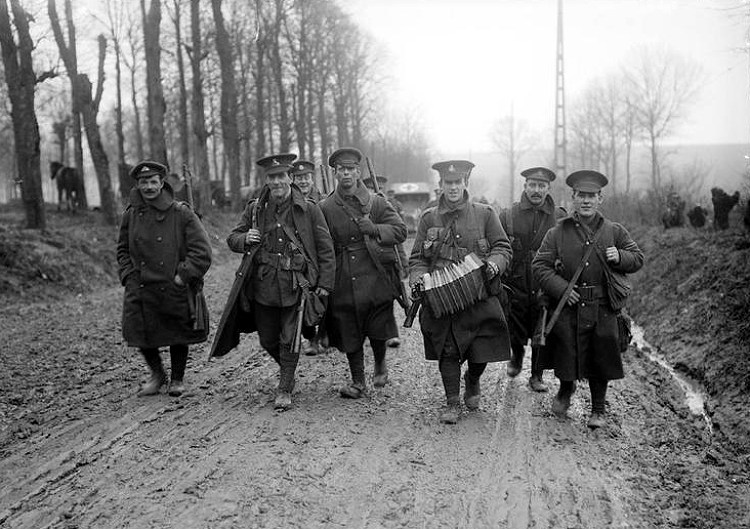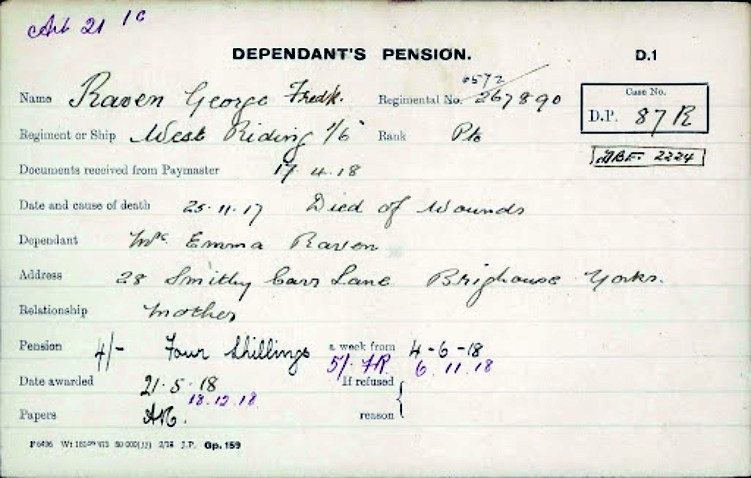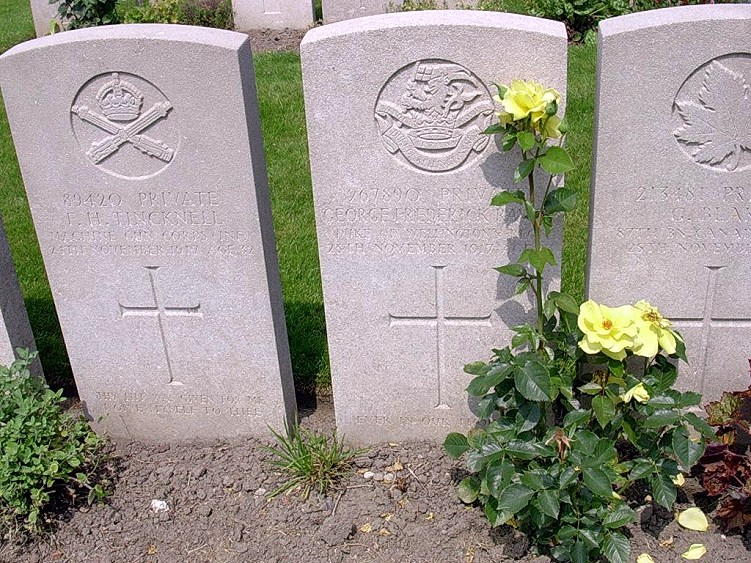Private George Frederick Raven, 267890, 1st/6th Battalion, Duke of Wellington's (West Riding) Regiment.
George Frederick Raven was born on the 27th of November 1894, and baptised on the 31st December 1894 along with his elder brother Charlie Raven at St Paul's Old Town Church, Barnsley. He was sixth of eight children born to policeman John William Raven (born 1859 in Kings Lynn, Norfolk) and his wife Emma (nee Elvin) who had married on the 18th March 1884 in Market Rasen, Lincolnshire. All eight of the Raven children were born in Barnsley, but one child Fred Raven died aged 5½ months in 1886.
George's father, John William Raven had joined the police force on the 13th November 1882 and, after serving his probationary period in Wakefield, he was sent to Barnsley where he remained until 1896. He was then transferred to Eccleshill, remaining there until November 1899. From there he was transferred to the Dewsbury area and was stationed at Ossett until 1903 when he was transferred to the Halifax Division.
When he retired on New Year's Eve 1907, John William Raven had served as a police officer for 25 years. He worked as a postman after his retirement. Later he was a member of the First Reserve, and in 1914 he resumed active duty for a short time guarding waterworks at Denshaw, Saddleworth. He died on the 1st June 1937 aged 79 years.
When his father became a policeman in Ossett, George Raven moved, with his family, to Ryecroft Street, Ossett at around the time of his fifth birthday. Seven years later, the Raven family then went to live in Brighouse at 7, Hardy Street, where they were living in 1911 and George Frederick, then aged 17 years, and prior to his war service, was employed as a silk dresser at Wood, Robinson & Co., silk manufacturers, established at Wilkin Royd Mill, Brighouse. He was also a keen cyclist and a member of the Wheelers Club which occupied 14 Huddersfield Road, next door to the Albert Cinema.
George at the age of 21 years, enlisted in the Army in August 1915 with the 1st/6th Battalion of the Duke of Wellington's (West Riding) Regiment which was formed on 4th August 1914 in Skipton as part of the 2nd West Riding Brigade, West Riding Division.
Following the outbreak of war, the battalion was mobilised and deployed to eastern coastal defences near Hull and Grimsby before moving to billets in Doncaster for the winter. During the spring of 1915, they trained in South Yorkshire and Lincolnshire. Re-designated the 1/6th Battalion, they sailed to France in April 1915 and formed part of the 147th (2nd West Riding) Brigade in the 49th (West Riding) Division, seeing action on the Somme, at Ypres, during the German Spring Offensive (1918) and the final Allied 100 Days Offensive.

Above: British troops returning from leave, Mailly Maillet, November 1916. The group of soldiers includes men of the Lancashire Fusiliers, York and Lancaster Regiment, and the Duke of Wellington's Regiment (West Riding), from the 49th Division.
Private George Raven was sent to the Western Front on Christmas Eve 1916. His service record hasn't survived but other, less comprehensive records have and these, combined with evidence from newspaper reports of the time, have allowed some of his service history to be pieced together. According to pension records, George Frederick Raven enlisted originally with service number 6572 in the 6th Battalion, which was later redesignated as the 1st/6th Battalion and when he was given the regimental number 267890.
When Private Raven was sent to the front line, by early 1917, the 1/6th were positioned to the west of Arras in the trenches. In July 1917 they moved to the French/Belgium border at Ghyvelde and then they were involved in Operations on the Flanders Coast at Nieuport in July and August 1917 then the Battle of Poelcappelle in October 1917.
In November 1917 the battalion moved to the trenches at Zillebeke, south of Ypres where there had been much previous fighting, notably around the infamous Hill 60. It was relatively quiet with few casualties until the evening of the 22nd November when the battalion was moved up to the front line. Heavy enemy shelling on the morning of the 23rd November 1917 resulted in the death of five officers and other ranks with another ten other ranks wounded.
Among those wounded was Private George Frederick Raven who succumbed to his wounds and died two days later on the 25th November 1917 when he was just two days away from his 24th birthday
Private George Frederick Raven was posthumously awarded the British and the Allied Victory Medals, but not the 1915 Star since he didn't serve overseas until late 1916.

It was said later of the battalion: "After nearly four years at the front, they had been transformed from part-time enthusiastic amateurs to battle hardened veterans, having fought in some of the Great War's major battles, including suffering the effects of mustard gas at Nieuport. It was a source of pride to the men of the battalion that they had never given up ground to the enemy, unless ordered to by a higher authority, and only then reluctantly".
Private George Frederick Raven died on the 25th November 1917, aged 23 years, the son of John William and Emma Raven, of Brighouse, Yorks. He is buried at grave position XXVII. BB. 19A in Lijssenthoek Military Cemetery.

Above: George Frederick Raven's grave (centre) at Lijssenthoek Military Cemetery.
The cemetery contains 9,901 Commonwealth burials of the First World War, 24 being unidentified. There are 883 war graves of other nationalities, mostly French and German, 11 of these are unidentified. There is one Non World War burial here.
Lijssenthoek Military Cemetery is located 12 km west of Ieper town centre, on the Boescheepseweg, a road leading from the N308 connecting Ieper to Poperinge.
Private George Frederick Raven is also remembered on the Brighouse War Memorial at Rydings Park, Halifax Road, Brighouse and on the memorial at St Martin's Parish Church, Brighouse where he and his brother Sergeant Charlie Raven are among the 49 named parishioners who died during WW1.
In August 2022 the name of George Frederick Raven, once of Ryecroft Street, Ossett was quietly added to the Ossett War Memorial.
My thanks to Anne-Marie Fawcett for her research on the Raven family.
Further researched and written in April 2023 by Stephen Wilson for ossett.net, the first established and only Ossett history website with original, non-plagiarised and accurate content.
References:
1. 49th Division, 147th Infantry Brigade, Duke of Wellington's (West Riding Regiment) 1/6th Battalion: 1 May 1915 - 16 June 1919 (First World War, War Diary, WO95/2801.